


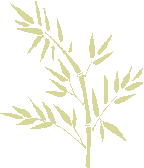

|
Home |
|
Classes |
|
Syllabus / Styles |
|
Biography |
|
Poetry |
|
Photos |
|
Articles |
|
Labyrinths |
|
Storytelling |
|
Artwork |
|
Respects Due |
|
Contact |
|
Links |


|
...with a spirit of self-exploration |

|
Pennine Tai Chi |



|
Juggling with Clubs, Wielding Weapons and Playing with Fire |
EtymologyAccording to the ‘Bloomsbury Dictionary of Word Origins’, the original meaning of the word ‘club’ is: ‘thick heavy stick for hitting people’. It also tells us that the word was borrowed from the Old Norse ‘klubba’. In this article we will look at some of the connections between the martial arts and the arts of club juggling and club swinging. First though, let’s look at another meaning of the word ‘club’. The same word can also be used to describe a group or association of people. Hence, the words ‘juggling club’ can have two meanings (similarly so can ‘golf club’). This second meaning of the word developed later and different theories for its origin have been put forward. One is that it may have developed from the notion of forming into a bunch or clump like the thick end of a club. An alternative explanation suggests that such a group / association became known as a club because it was called together by a ‘club-bearer’. Here we see the club being used to portray power or authority. Examples of this association with power and authority can be seen in our myths.
MythologyIn Greek mythology, the mighty Heracles (Roman – Hercules) was famous for using his club to assist in various tasks on his twelve great labours. In Indian Mythology, the Monkey God - Hanuman, is usually depicted with a large club or mace, which is seen as a symbol of his strength. |
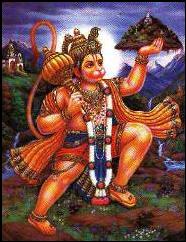
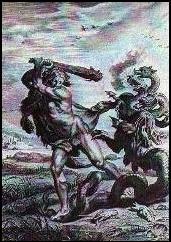
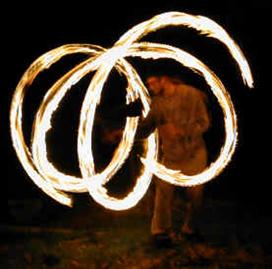
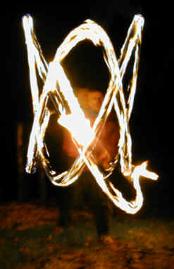
|
Juggling ClubsThis throw skyward is also the precursor of the juggle. Things tend to be sent downwards to earth in anger and annoyance, upwards to the sky in joy and celebration. Juggling would appear to be a joyful act, at least whilst we keep the objects in the air. Our spirits soar while the objects remain in motion, and sink when they plummet to the ground. When juggling we are applying an element of levity to a situation of great gravity. The throw itself can have different intentions. In conflict, a throw at another aims to hurt or harm, whilst in a game or when juggling, a throw to another person aims to help or harmonise. When club passing with another person or within a group, such harmonisation entrains the rhythms of those taking part (and to a lesser extent those watching).
Close Relations to the ClubThe bone used as a weapon and the juggling club have many close relations. The Irish Shillelagh is a wooden club made from a stout knotty stick with a large knob on the end, and is a fearsome weapon. Native American War Clubs can still be seen in some museum collections and have similar relations in most cultures. The Truncheon (or Nightstick in American English) is a short club used predominantly for law enforcement or by security personnel. The Side Handle Baton is now used by many police forces and is derived from the Japanese Tonfa. The Baseball Bat is essentially a club that is used to strike a ball instead of a person. The Mace is an advance on the club with a longer shaft and a head that is usually made of metal. The marching mace is often used with twirls and throws, whereas the ceremonial mace is more a representation of power and prestige. Kings and queens often use the sceptre as a symbol of sovereignty. Medieval bishops carried maces as opposed to bladed weapons so as to conform to the canonical rule that forbade priests to shed blood. In other words they could bludgeon someone as long as blood wasn’t spilt, and the mace was perfect for the job!
Swinging ClubsModern club swinging has roots in Indian martial arts. As well as being used as weapons, clubs were sometimes used with fire and it is said that their use originates from techniques for frightening animals, such as elephants, that were being used by enemy armies. It would have been possible to devastate an entire army and throw it into disarray by turning the charge of its elephants back upon itself and thereby repelling the invaders even before fighting was necessary. |
|
This use of fire clubs could possibly be the point where the practice of club swinging began. To employ the club as a weapon or a tool, a firm and full handhold is required. By contrast, if the club is alight and the prime purpose is to emphasise the movement, then a looser handhold facilitates that mobility and flow. It is easy to imagine how this new and adapted use of the club came to be developed as an art in itself. The British army in India took up club swinging with wooden clubs as a gymnastic exercise for coordination and upper body strength. Early books on the subject such as ‘Club Swinging’ by W. J. Schatz published in 1908, show this type of approach. More recently, club swinging has developed in the West in modern rhythmic gymnastics and as a circus art. Yet another dimension is the use of ultraviolet light or ‘black light’. This means that luminous or fluorescent colours can be used to create optic traces whereby multiple patterns are transcribed into space, creating a rich visual weaving of rhythmic movement.
Past, Present and Future – Time and SpaceWhen we juggle or swing clubs, we are carrying on a long tradition and perhaps satisfying some basic instinct, a desire to connect the three dimensions of: up and down (heaven and earth), right and left (intellect and intuition), forward and back (us and them). What is more, if time is the fourth dimension, by playing with rhythm, maybe we even come to some intrinsic appreciation of the relativity of time.
Bibliography The Way of the Warrior by Howard Reid and Michael Croucher The Juggling Book (The Secret Identity of the Juggler) by David Latini Modern Club Swinging by Anna Jillings The Bloomsbury Dictionary of Word Origins Wikipedia Free Encyclopedia |
|
SymbologyFurther evidence of the symbolism attached to clubs, is seen in their use as one of the suits in a pack of playing cards. The suit of clubs relate directly to batons / rods / sceptres in the Tarot just as spades in playing cards relate to swords in the Tarot. For anyone wishing to immerse themselves in the Tarot, it offers a world rich in meaning and symbolism.
The Club as a Weapon and a ToolThe club was perhaps the first of all weapons and tools. It is the simplest most basic thing for creatures having a hand formed with thumb and fingers, to take hold of and grip. David Latini in his thought provoking writings in ‘The Juggling Book’, takes us back to prehistory as depicted in the film ‘2001 A Space Odyssey’. A group of ape-like creatures, maybe our ancestors, have gathered when a dispute arises. One ape picks up a bone that it uses as a club to kill its adversary. Here we can imagine perhaps the first use of the |
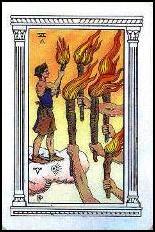
|
Hercules and the Hydra by B. Picart |
|
Hanuman the Monkey God |
|
VI of Rods from the Alchemical Tarot by Robert M. Place |
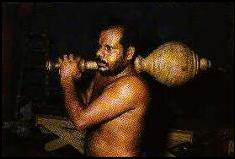
|
club as a weapon. In a celebration of victory the club is hurled high into the sky where it twists, twirls and turns, until as it approaches the zenith of its flight, it is transformed into a spaceship serenely travelling through space. Here we have swiftly been transported from the time of our forebears to the time of our children’s children’s children. Within this short sequence of events we see two acts with the club: one the action of striking and one the action of throwing, (the act of beating down to the ground and the act of throwing up to the sky). David Latini suggests that the throwing of an object skyward may be one of the first ways of acknowledging the heavens and the possibility of a Creator. |
|
Kalari practitioner with large club |